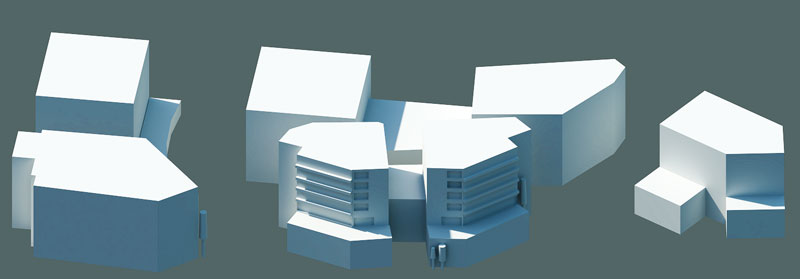Es2_Analysis of the solar radiation_QUARTIERE AURELIO/QUARTIERE OSTIENSE
- ANALYSIS OF THE SOLAR RADIATION - VIA BONAVENTURA CERRETTI_QUARTIERE AURELIO
About this second delivery, we've studied the solar radiation of the buildings already developed during the first one, in order to verify the advantages and disadvantages.

After the creation of the volumes (we've added other ones to study solar radiation more precisely), we've sketched the openings of the windows and balconies in the facades studied in the first exercise.
FIRST STEP : clicking on SET, select the facade on which to draw the punch.

Draw a rectangle with CREATE FORM --> VOID FORM to extrude window.

Finally, to complete the modeling click on FINISH MASS.
SECOND STEP : Now, we can start the study of the solar radiation clicking on ANALYZE --> SOLAR RADIATION

THIRD STEP :
1) Select the facades you want to analyse

2) Clicking on SOLAR RADIATION --> SETTINGS we can set date and time which we want to study.

FOURTH STEP : To analyze the radiation on the buildings, we've decided to study the most significant and different seasons of the year, winter and summer.
MULTIDAY WINTER STUDY

MULTIDAY SUMMER STUDY

We've considered especially the two facades facing North, in which we've realized openings of the windows and balconies.




FIFTH STEP : In SOLAR RADIATION --> STYLE, we can create a new style setting (we've chosen, for example, ES2_NUMERI).

The next step is modify SETTING, COLOR, LEGEND



Besides, It’s possible to change the density of the numeric indicators of the radiation clicking on ANALYSIS ACCURACY if they're too big or too little in the model.
NORTH FACADE ON WINTER

NORTH FACADE ON SUMMER

SIXTH STEP : Besides, we wanted to see which parts of the two buildings could be impaired during th whole year because of the solar radiation so we have clicked on ANALYZE --> SOLAR RADIATION --> SETTINGS, we've set ONE YEAR SOLAR STUDY and then SUNRISE TO SUNSET.
Our impressions: it can be noticed that both of facades facing North receive a light solar radiation. That can be considered a disadvantage or an advantage. Infact, during winter, living rooms and kitchens are quite cold and that's because the small balconies aren't able to retain the heat of the sunlight and to transmit it to the adjacent rooms. North facade is very cold even because being in front of a park without any shields involves the rooms will be less comfortable in winter and it will be necessary to provide the heating inside them. On the other hand, during summer, living rooms and kitchens will be very illuminated so as they will be even the freshest and most comfortable areas of the house. In the end, we can notice that the biggest balconies receive more sunlight than the others and their depth prevents sunlight from having direct contact with the rooms, which reduces the temperature inside of them.
As soon as possible we've decided to add meaningful and detailed pictures of the facades, in order to study which parts of the building have been deteriored by mold and humidity because of a bad exposition or a low radiation during the whole year.



Observing these buildings, we've noticed they show some deteriored areas which are covered by humidity, mold and moss. The balconies (perphaps 'cause of infiltrations) and the walls next to the floor are especially damaged in this sense: this capillary moisture rising from the ground is probably caused by the errors of work or the lack of waterproofing; otherwise, we could face a similar situation even if the waterproofing isn't perfectly funtioning. The damp walls from lifts are caused by building materials that absorb the moisture from the soil. On the other hand, humidity can be produced by water spray from vehicles which pass through the street next to the buildings. However, this happens because these parts receive less sunlight than the others.
- ANALYSIS OF THE SOLAR RADIATION - AREA DI PROGETTO_QUARTIERE OSTIENSE
The area which we've to study is located between Via del Porto Fluviale and Via del Commercio.
The program involves the realization of a building with differentiated functions: residences, shops and ateliers. It should be measure 7100 mq (about 21.850 mc). Will be carried out different types of apartments ranging from 25 mq to 100 mq for more users, such as families looking for stable situation, young singles, students, unemployed looking for temporary houses.

We've started the study of the area although we have not realized our project yet. So we've analyzed some moments of the year.
SPRING EQUINOX_H 9

SPRING EQUINOX_H 17

On spring, the area seems more comfortable than on winter: in the morning the adjacent building cast their considerable shadow over it; on the other hand, in the afternoon, the sunlight is more cozy and appreciated.
WINTER SOLSTICE_H 9

WINTER SOLSTICE_H 17

On winter the area is completely dark, so it begins quite cold and inhospitable, especially at 9 a.m.
SUMMER SOLSTICE_H 9

SUMMER SOLSTICE_H 17

We can notice how the area is very sunny during summer: the adjacent buildings don't cast any shadows on it, so it's hot and not protected from solar radiation, except at 9 a.m.
At this point we've analyzed the effects of the radiation solar on this area.
MULTI DAY STUDY_WINTER


MULTI DAY STUDY_SUMMER


From this study, it can be noticed the area realized with Vasari software is quite liveable during winter, even if the facades facing North seems more cold than others. That could be considered an advantage during summer but, according to me, it could be necessary to provide a green area to this district, so it can shade the sunlight during the hottest hours.



